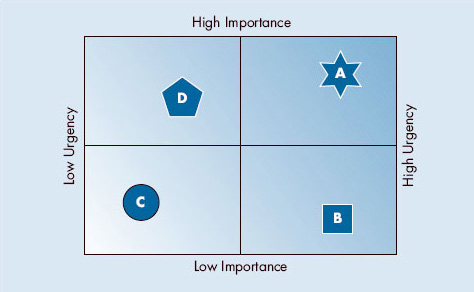3 Decisions, decisions: dealing with tasks
3.1 A matter of urgency
While it is important for managers to develop an understanding of individual jobs or tasks and how they can be done efficiently and effectively, a lot of the time management work is about juggling these many different tasks and activities. Managers often need to make decisions about which tasks to focus on, when they should be worked on and for how long. So how do they decide? There are a couple of simple techniques which can help here. The first is about identifying your priorities, and the second is about assessing the difficulty of the task.
The volume of tasks most of us are asked to deal with in a typical working day is a great source of personal stress. This, in turn, can be a significant obstacle to our effectiveness. The most common response to a seemingly overwhelming and stressful workload can be likened to fire fighting: deal with tasks only when they are starting to cause a problem. A simple way of addressing them is to try to establish how urgent a task or problem is and how important it is.
An urgent task is something which either has a very short deadline or requires immediate attention because failure to address it will impact on the other tasks or routines. The ordering of tasks may be connected to your own work schedule or it may hold up the schedule of others’ work. Urgency (or non-urgency) is an assessment of how quickly a task must be tackled.
An important task is something which has more wide-ranging and far-reaching effects than on your own day-to-day working routine. It generally has a longer-term impact on your work and the work of others over whom you have a degree of authority or responsibility, for example, by affecting the flow of resources within your department, business or household or the way you choose to organise process activities. The importance or otherwise of a task will tend to guide how much time you might wish to spend on it.
It is worth bearing in mind that urgency and importance are not alternatives – all the tasks have to be done, after all! The task prioritisation grid shown in Figure 10 can be used to help you classify your work tasks by urgency and importance.

The grid contains four different task types to illustrate how it might be used.
Task A is high importance and high urgency. In other words, it is something which needs to be done quite quickly and has a longer-term impact on your work and possibly the work of others. So it is likely to be fairly time-consuming. Examples of these types of task are subject to individual and organisational circumstances, but some you might be familiar with are: filing tax returns; producing a monthly staff duty rota; or, in a household setting, getting your children to school.
Task B is high urgency but low importance. It requires speed but should not be too time-consuming. Dealing with emails or phone call requests for information are typical examples.
Task C is low importance and low urgency. These types of task may be to do with information you receive which does not require your response but may add to your decisions about other tasks.
Task D is high importance but low urgency. These will be time-consuming, probably requiring some reflection on your part, but your output is not required for some time. Of course, the longer this task is left, the closer to the deadline it becomes and the more urgent it becomes, like Task A.
Activity 4
Most of us, whatever our work entails, tend to have several tasks and activities to perform in a typical working day. Some people, and you may be among them, periodically write a list of all the tasks they need to do – it is often called a ‘To Do’ list. To start this task, write your own ‘To Do’ list of the outstanding tasks you have to perform in the next day or two. Give a number (1, 2, 3, 4 and so on) to each of the items on the list. Spend no more than five minutes on this part of the activity and try to list between five and ten items.
Now quickly draw a task prioritisation grid like the one in Figure 10. Try to place each of the numbered items on your ‘To Do’ list in the appropriate box on the grid. This is not always easy to do and may require some thought, but try to make sure each numbered item is placed in the box you think is appropriate. What does this tell you about the work you do?
Discussion
This task is intended to make you think carefully about something you may do regularly and quickly or you may not have done before. As such you may have found it quite difficult, but we hope you found interesting what it indicates about the work you do. You may have found the tasks evenly spread around the four boxes or they may be heavily weighted towards the urgent or the important. To a degree this depends on the job you have, the organisation you work for and the sector you work in. For example, someone who works in telesales, a restaurant kitchen or in a hospital accident and emergency unit is probably likely to have a high number of urgent tasks, given the fast pace of activity. On the other hand, someone who works as a Health and Safety Compliance Officer, or in book-keeping would have fewer urgent and more important tasks, given the need for accuracy and the impact of their work on others.
